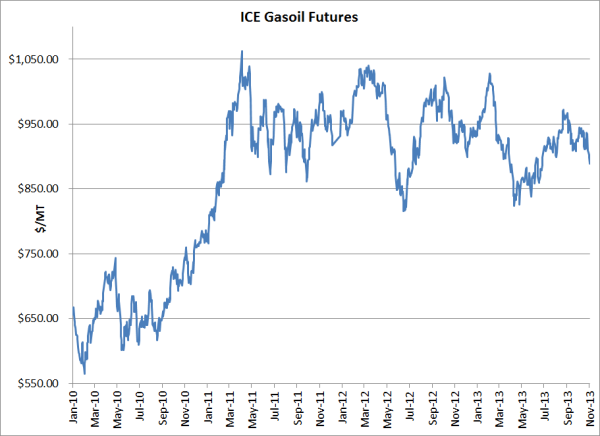3 min read
Fundamentals of Global Fuel Risk Management
As crude oil and refined products prices once again seem to be on an upward trend, we've received several requests for more information on the basics...

This post is the second in a series where we are explaining the most common fuel hedging strategies utilized by commercial and industrial fuel consumers. You can access the first post, which explained diesel fuel hedging with CME/NYMEX ultra-low sulfur diesel fuel futures, via the following link: A Beginners Guide to Fuel Hedging - Futures. In subsequent posts we will address how fuel consumers can hedge with options as well as more advanced hedging strategies such as costless collars and call option spreads.
A swap is an agreement whereby one party exchanges their exposure to a floating (often referred to as spot, index or market) fuel price for a fixed fuel price, over a specified period(s) of time. Swaps are available on nearly all types of fuel including bunker fuel, diesel fuel, gasoil, gasoline, heating oil, jet fuel, fuel oil, etc. Swaps received their name as the buyers and sellers of swaps are “swapping” cash flows with one another - floating for fixed and vice versa.
As noted in the previous article regarding fuel hedging with futures, swaps are often a more ideal fuel hedging instrument, as opposed to a futures contract, because futures contracts generally expires on a specific day each month while swaps settle based on the average price over the course of the month. The swaps settlement style is clearly better aligned with the way the vast majority of commercial and industrial consumers purchase fuel.
Commercial and industrial fuel consumers in numerous industries (air, marine, rail and road transport, manufacturing, mining, processing, etc.) utilize swaps in order to hedge their fuel price risk by fixing or locking in their fuel costs. Similarly, many fuel marketers, refiners and traders utilize swaps to hedge their inventory and margins as both are impacted by price volatility. Many fuel marketers also utilize swaps to hedge their price exposure associated with the sale of fixed price fuel. In addition to fuel and other energy commodities, swaps are also utilized by companies seeking to hedge their exposure to foreign exchange, interest rates, metals, agricultural commodities and more.
As an example of how one can utilize a fuel swap to hedge their exposure to volatile fuel prices, let's assume that you're an airline who wants to lock in a fixed price for a portion of your anticipated jet fuel price exposure. For sake of simplicity, let's assume that you are an Asia based airline and need to hedge your anticipated fuel consumption in November. In order to do accomplish this you could purchase a November jet kerosene swap from one of your counter-parties, often the commodity trading division of a bank or major oil company. If you had purchased this swap yesterday at the prevailing market price, the price would have been approximately $ 57.25 per barrel.

Now let’s examine how the swap will impact your costs if Singapore jet kerosene prices during November average both higher and lower than the price at which you paid for the swap, $57.25/BBL.
In the first situation, let's assume that Singapore jet kerosene prices in November are higher and that the average price for Singapore jet kerosene as published in Platts' Asia Pacific/Arab Gulf Marketscan for each business day in November is $75/BBL. In this situation, your swap would provide you with a hedging gain of $17.75/BBL ($75-$57.25=$17.75). As a result, you would receive a payment of $17.75/BBL from your counter-party, which would offset your actual fuel cost by $17.75 per barrel.
In the second situation, let's assume that Singapore jet kerosene prices in November are lower and that the average price for Singapore jet kerosene, again as published in Platts' Asia Pacific/Arab Gulf Marketscan for each business day in November, is $45/BBL. In this situation, your swap would result in a hedging loss of $12.25/BBL ($57.25-$45.00=$12.25). As a result, you would be required to make a payment of $12.25/BBL to your counter-party, which would increase your actual fuel cost by $12.25/BBL.
As this example indicates, purchasing a jet fuel swap allows an airline to hedge their exposure to unpredictable jet fuel prices. If an airline purchases a swap and the price of jet fuel increases, the gain on the swap will offset the increase in their actual fuel expense. Conversely, if the price of jet fuel declines, the loss on the swap will offset the decrease in their actual fuel expense. As a result, when an airline hedges with a fixed price swap, the airline is “locking in” their jet fuel cost regardless of whether jet fuel prices are higher or lower when their swap expires.
While this example examines how an airline can utilize swaps to hedge their exposure to jet fuel prices, the same methodology can be utilized to hedge bunker fuel, diesel fuel, gasoil, gasoline, etc.
As previously mentioned, fuel marketers, traders and refiners can also employ swaps to hedge their exposure to fuel prices as well. As an example, a refiner who needs to hedge their exposure to potentially declining diesel fuel costs (as the market value of their inventory/stocks changes in line with market prices) could do so by selling (also known as shorting) a diesel fuel swap.
This post is the second in the series titled A Beginners Guide to Fuel Hedging. The other posts in the series can be found via the following links:
Part I: A Beginners Guide to Fuel Hedging - Futures
Part III: A Beginners Guide to Fuel Hedging - Call Options
Editor’s Note: The post was originally published in August 2012 and has recently been updated to reflect current market conditions.

3 min read
As crude oil and refined products prices once again seem to be on an upward trend, we've received several requests for more information on the basics...

3 min read
As many companies are beginning to plan for 2014, we have received quite a few inquiries from companies who are looking into hedging their gasoil...

3 min read
As we've recently received inquires from several airlines who are looking to begin hedging their jet fuel price risk for the first time, we thought...